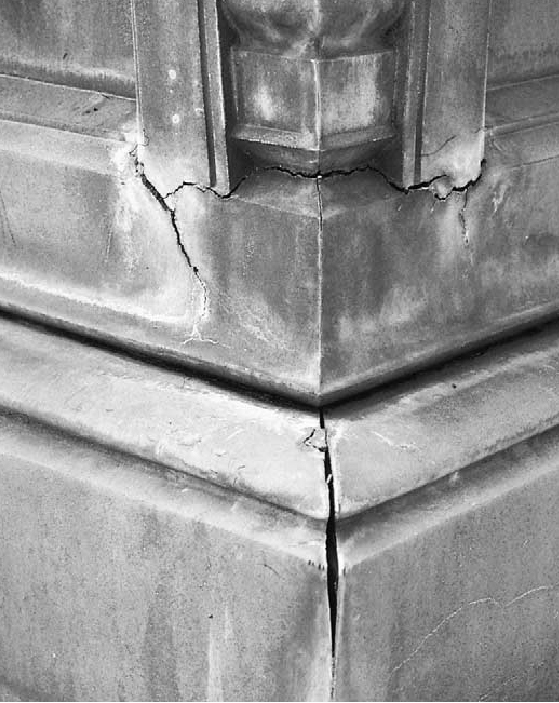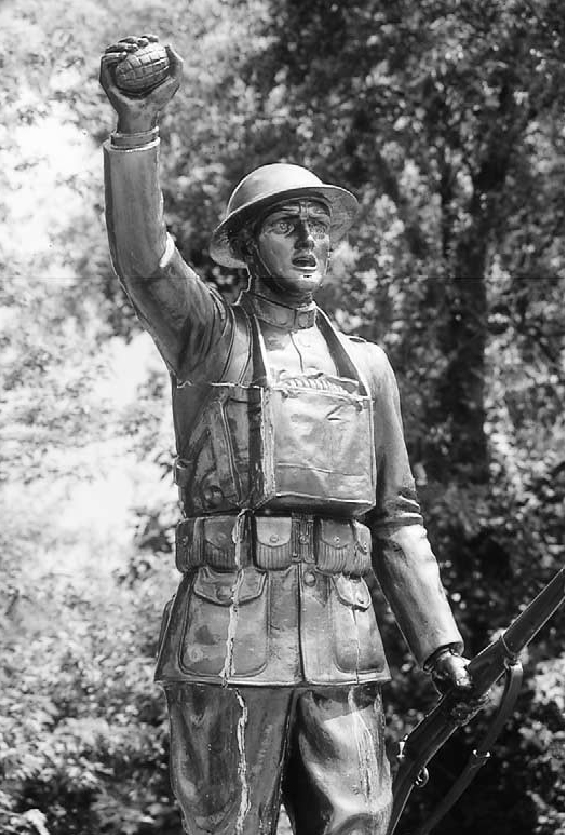THE CONSERVATION OF AMERICAN WAR MEMORIALS MADE OF ZINCCAROL A. GRISSOM, & RONALD S. HARVEY
3 DETERIORATIONZinc war memorials are typically more well cared for than other zinc sculptures in the public domain because they have organized advocates in veterans' groups. Surrounding areas tend to be landscaped and regularly decorated with flags and wreaths, even in winter amid snow. Vandalism seems to occur less often, prevented also by the fact that many soldiers are relatively inaccessible on tall pedestals. Zinc war memorials are also more likely than other zinc statues to be repaired when damaged. Unfortunately, frequent repairs sometimes accelerate damage when choices of conservation techniques are ill-informed. The most common reason that a zinc soldier is brought to the attention of a conservator is breakage. Cast zinc is far more brittle than bronze, and when cast-zinc statues fall from pedestals, the metal is often described as having “shattered.” Jagged fractures run across zinc fragments, typically revealing at their edges the large metallic grains that form as zinc cools in sand molds. Close examination usually shows that seams have also come apart, probably because there were incipient cracks. Lead-tin solder seams are often found cracked on statues that appear intact, and white-bronze joins tend to separate over time One of the unfortunate properties of zinc is that it creeps (deforms over time) under its own weight. As a result, life-size cast-zinc statues may exhibit lean when the center of gravity is eccentric to the center of the statue's base. White-bronze soldiers seem to be damaged by this phenomenon more often than their painted counterparts. The Colorbearer, for instance, invariably leans toward the eccentrically placed flag (steps taken to compensate for one example's lean are visible in fig. 7). The American Soldier often sinks into the base at his right heel, causing the statue to lean backward and slightly to the figure's right. While a downward deflection of one cm at the heel appears slight, the concomitant lateral deflection of some 6 cm at the head of a life-size statue is visually disturbing as well as cause for alarm (see fig. 5). On account of their size and weight, the multitiered white-bronze bases often exhibit more perilous structural problems resulting from creep. The metal skin may sag downward where unsupported by an armature, and it often bulges outward at the base. Cracks occur at the interface of thick and thin areas adjacent to joins. For example, vertical cracks are often found about 5 cm from the corners on the base. Galvanized-iron columns have been found out-of-vertical and no longer supporting the corners of the monument, and stiffener plates have buckled as weight was transferred to them (see fig. 8). Well-intentioned treatments to improve support may lead to greater damage, especially the all-too-frequent partial or complete filling of monument bases with concrete. Concrete shrinks upon setting, typically leaving narrow gaps between the fill and metal. Water eventually finds its way to the gaps and places enormous pressure on the metal as it expands with freezing. Severe cracking results, accompanied by the accumulation of concrete exudates on adjacent surfaces (fig. 9). In a few instances, damaged portions of monuments have been removed, leaving the monuments truncated. For instance, the once-magnificent nearly 13 meter high Soldiers and Sailors Monument (1888) in Portsmouth, New Hampshire, is now missing two middle sections and about 5 meters of its original height. While concrete has been used less frequently to fill the statues themselves, results are similar. Other fillers can cause problems as well, such as a plasterlike material inside the Doughboy in Verona, Pennsylvania (fig. 10). Zinc forms reasonably stable corrosion layers except when atmospheres contain significant sulfur or chlorine (Grissom 1994). Even, light blue-gray patinas on aged white-bronze monuments seldom call for cleaning on aesthetic grounds, contrasting with uneven black-and-green patinas on bronze statues erected at the same time. White-bronze monuments may be disfigured by graffiti scratched through the light-colored corrosion products on their surfaces. The scratches are rendered visible by the
The most common problem for sheet-zinc statues is denting. The ductility produced by sheet zinc's uniformly small grain size typically prevents brittle breakage. If paint is not maintained, sheet-zinc statues may be perforated by corrosion, especially where the metal became thinner during the stamping process. |

